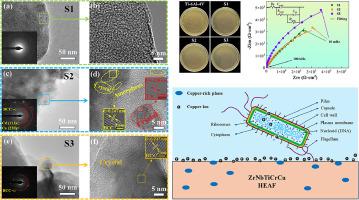A significant improvement in corrosion resistance and biocompatibility in ZrNbTiCrCu high-entropy films induced by the precipitation of Cu
IF 11.2
1区 材料科学
Q1 MATERIALS SCIENCE, MULTIDISCIPLINARY
引用次数: 0
Abstract
Utilizing nanotechnology and composites to create a protective film on titanium alloy is an effective means of achieving the desired high performance. Self-assembly of nanocomposite structures offers a promising route to forming high entropy alloy films (HEAFs), but controlled preparation remains challenging. This work used magnetron sputtering through adjusting preparation parameters to prepare ZrNbTiCrCu HEAFs, achieving a significant improvement in corrosion resistance and biocompatibility induced by the precipitation of Cu. According to the electrochemical corrosion test, without obvious corrosion pits on the surface of S2 after corrosion, a passivation film composed of bimetallic oxide CuCrO2 formed on the film surface, indicating that ZrNbTiCrCu HEAFs have remarkable corrosion resistance performance. In the cytocompatibility experiment, the cell viability of HEAFs reached over 95 % due to the precipitation of Cu, suggesting their excellent biocompatibility. In addition, ZrNbTiCrCu HEAFs exhibit outstanding antibacterial ability, especially when the sputtering current is 0.6 A, and the in vitro antibacterial rate of the sample against Escherichia coli is close to 99 %.

铜沉淀诱导 ZrNbTiCrCu 高熵薄膜耐腐蚀性和生物相容性的显著改善
利用纳米技术和复合材料在钛合金上形成保护膜是实现所需的高性能的有效手段。纳米复合材料结构的自组装为形成高熵合金薄膜(HEAF)提供了一条前景广阔的途径,但可控制备仍具有挑战性。本研究通过调整制备参数,利用磁控溅射技术制备了 ZrNbTiCrCu HEAFs,通过 Cu 的析出显著提高了其耐腐蚀性和生物相容性。电化学腐蚀实验表明,腐蚀后的 S2 表面无明显腐蚀坑,薄膜表面形成了由双金属氧化物 CuCrO2 组成的钝化膜,表明 ZrNbTiCrCu HEAFs 具有显著的耐腐蚀性能。在细胞相容性实验中,由于 Cu 的沉淀,HEAFs 的细胞存活率达到 95% 以上,表明其具有良好的生物相容性。此外,ZrNbTiCrCu HEAFs 还具有出色的抗菌能力,尤其是当溅射电流为 0.6 A 时,样品对大肠杆菌的体外抗菌率接近 99%。
本文章由计算机程序翻译,如有差异,请以英文原文为准。
求助全文
约1分钟内获得全文
求助全文
来源期刊

Journal of Materials Science & Technology
工程技术-材料科学:综合
CiteScore
20.00
自引率
11.00%
发文量
995
审稿时长
13 days
期刊介绍:
Journal of Materials Science & Technology strives to promote global collaboration in the field of materials science and technology. It primarily publishes original research papers, invited review articles, letters, research notes, and summaries of scientific achievements. The journal covers a wide range of materials science and technology topics, including metallic materials, inorganic nonmetallic materials, and composite materials.
 求助内容:
求助内容: 应助结果提醒方式:
应助结果提醒方式:


